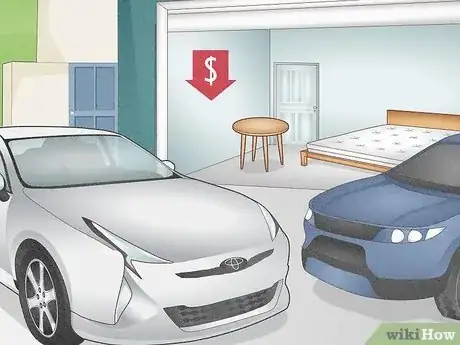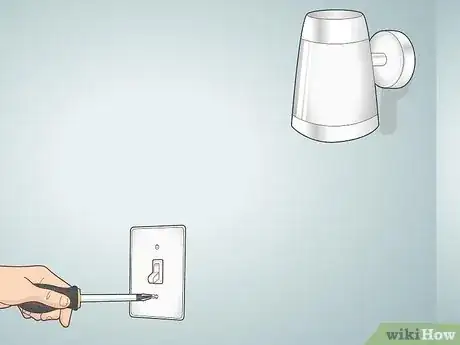This article was co-authored by Josh Goldenberg and by wikiHow staff writer, Hunter Rising. Josh Goldenberg is a Residential Remodeling Expert and the Co-Founder of 5blox, based in the Greater Los Angeles area. With more than seven years of experience, Josh and his team specialize in luxurious and sustainable home renovations. 5blox is fully licensed and bonded.
There are 13 references cited in this article, which can be found at the bottom of the page.
This article has been viewed 9,941 times.
If it’s getting a little cramped and you need some extra space to spread out in your home, converting a garage gives you a lot of room. While you may be eager to start turning your garage into a room, there are some considerations and hidden costs to think over before you begin. Keep reading for a complete guide on everything you need to know and how you can save money before you start your renovations.
Things You Should Know
- A full, up to code garage conversion costs between $5,000 and $20,000 USD. However, the renovations may increase the overall value of your home.
- You'll need to insulate and finish the floors, walls, and ceilings to bring the room up to code. You may also need to add windows and electrical wiring.
- Simple drywall is the most cost-effective finish for your walls. Insulate and use drywall on your ceilings for an interim solution before fully finishing them.
Steps
Planning Your Garage Conversion
-
1Get estimates from contractors. While you can do some of the renovation work yourself, professional contractors should do any work you’re uncomfortable with. Call a few different places to get multiple estimates so you can get a rough idea of how much it will cost to turn your garage into a room.[17]
- Ask the contractors for customer referrals so you can get a better idea of how well they work.
-
2Create a budget and timetable for renovating your garage. Once you have a ballpark estimate for the costs of your renovation, set aside enough money and time to complete it. Factor in about 5–10% more time and money than you need just to be on the safe side.[18]
- Some contractors might have financing options so you can pay them over time.
Warnings
- It may be illegal to convert a garage into a living space in your area unless you get a permit.[19]⧼thumbs_response⧽
Expert Interview

Thanks for reading our article! If you'd like to learn more about home improvement, check out our in-depth interview with Josh Goldenberg.
References
- ↑ https://nickiandkaren.com/ask-a-realtor/convert-garage-into-magnificent-space/
- ↑ https://cao-94612.s3.amazonaws.com/documents/Oakland-ADU-Guide-11.5.2020.pdf
- ↑ https://www.propertyroad.co.uk/should-i-convert-my-garage-into-living-space/
- ↑ https://www.moneypit.com/garage-conversions-spare-rooms-ideas-and-costs/
- ↑ https://nickiandkaren.com/ask-a-realtor/convert-garage-into-magnificent-space/
- ↑ https://www.ci.scappoose.or.us/sites/default/files/fileattachments/building/page/8681/convert_garages_or_attics_to_livable_space.pdf
- ↑ https://www.ci.azusa.ca.us/986/Illegal-Garage-Conversions
- ↑ https://mybuildingpermit.com/sites/default/files/inline-files/Tip%20Sheet%2025%20Garage%20Conversions.pdf
- ↑ https://www.ci.milpitas.ca.gov/_pdfs/bld_permit_sr_res_garage_conversion.pdf
- ↑ https://www.ci.scappoose.or.us/sites/default/files/fileattachments/building/page/8681/convert_garages_or_attics_to_livable_space.pdf
- ↑ https://www.contracosta.ca.gov/DocumentCenter/View/48779/RESIDENTIAL-GARAGE-CONVERSION
- ↑ https://mybuildingpermit.com/sites/default/files/inline-files/Tip%20Sheet%2025%20Garage%20Conversions.pdf
- ↑ https://www.garlandtx.gov/3164/Garage-Conversion
- ↑ https://www.ci.milpitas.ca.gov/_pdfs/bld_permit_sr_res_garage_conversion.pdf
- ↑ https://www.ci.milpitas.ca.gov/_pdfs/bld_permit_sr_res_garage_conversion.pdf
- ↑ https://journals.sagepub.com/doi/10.1177/0739456X17741965
- ↑ https://www.hcd.ca.gov/policy-research/accessorydwellingunits/docs/guidelines%20for%20garage%20conversion%20adus%20-%20v6hb%20ada.pdf
- ↑ https://www.bhg.com/home-improvement/advice/how-to-create-home-improvement-project-budget/
- ↑ https://www.ci.azusa.ca.us/986/Illegal-Garage-Conversions









































































